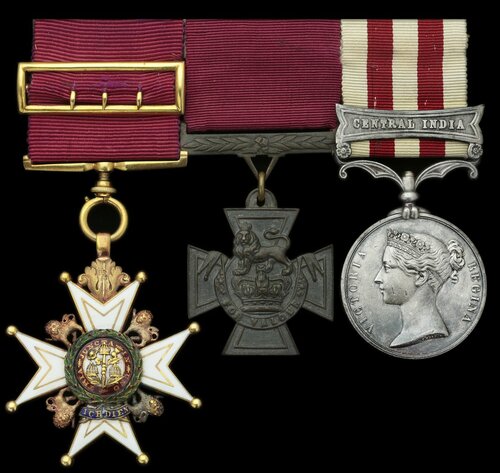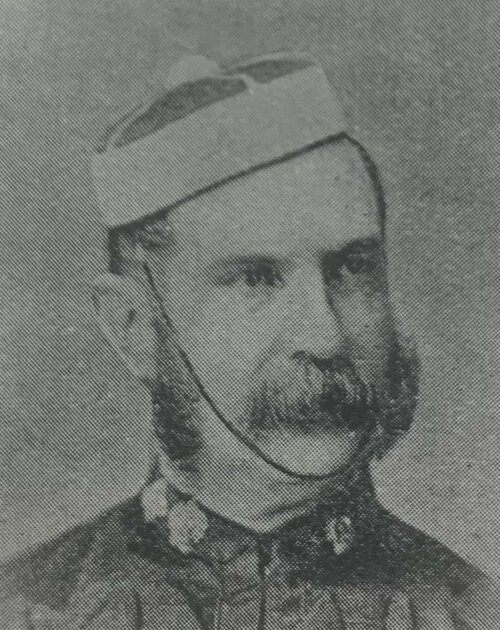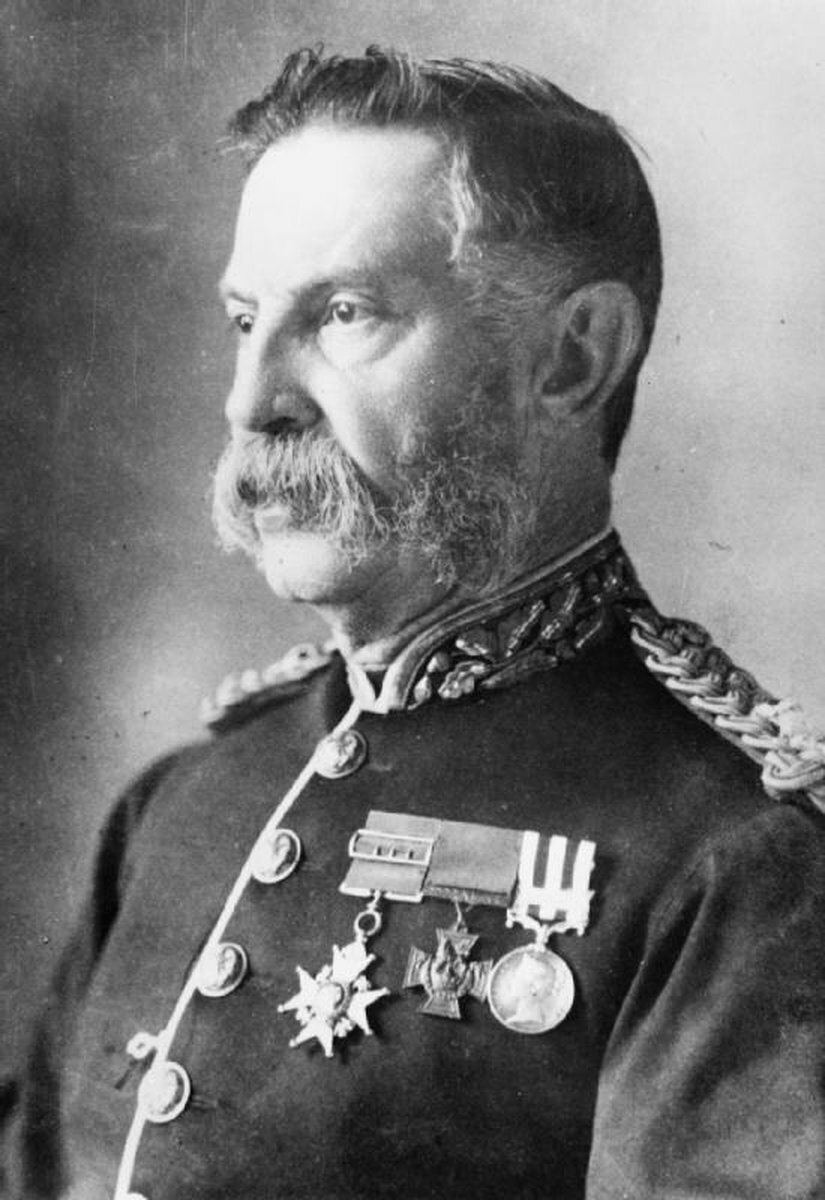Auction: 21002 - Orders, Decorations and Medals
Lot: 263
(x) The superb C.B., Indian Mutiny V.C. group of three awarded to General J. Blair, 2nd Bombay Light Cavalry
Blair was decorated for his remarkable bravery in two separate hand-to-hand actions, one of which saw him required to use the broken hilt of his sword to personally lead a charge against the enemy after he had broken the blade against the head of one of his enemy - being severely wounded on both occasions - he latterly shared in the Siege of Neemuch, the Storming of Kotah and the pursuit of the famed Mutineer General Tatya Tope; Blair latterly had a fine spell as Resident in Aden during a period of high interest and intrigue
The Most Honourable Order of the Bath, C.B. (Military) Companion’s breast Badge, gold (22 carat) and enamel, hallmarks for London 1887, with integral gold ribbon buckle; Victoria Cross, reverse of suspension bar engraved 'Captn. James Blair 2d. Bombay Lt. Cavalry', reverse of Cross engraved 'Augt. 12 Octr. 23 1857.'; Indian Mutiny 1857-59, 1 clasp, Central India (Captn. I. Blair, 2nd Regt. Bombay Cavy.), mounted as worn, note initial upon Medal, good very fine, housed within a leather glazed open-fronted case, with tooled lettering 'General James Blair V.C. C.B.' (3)
Purchased Spink, 1969.
C.B. London Gazette 25 May 1889.
V.C. London Gazette 25 February 1862:
For having on two occasions distinguished himself by his gallant and daring conduct.
1. On the night of the 12th of August, 1857, at Neemuch, in volunteering to apprehend 7 or 8 armed mutineers who had shut themselves up for defence in a house, the door of which he burst open. He then rushed in among them and forced them to escape through the roof; in this encounter, he was severely wounded. In spite of his wounds he pursued the fugitives, but was unable to come up with them, in consequence of the darkness of the night.
2. On the 23rd of October, 1857, at Jeerum, in fighting his way most gallantly through a Body of rebels who had literally surrounded him. After breaking the end of his sword on one of their heads, and receiving a severe sword cut on his right arm, he rejoined his troop. In this wounded condition, and with no other weapon than the hilt of his broken sword, he put himself at the head of his men, charged the rebels most effectually, and dispersed them.'
James Blair was born on 27 January 1828, at Neemuch, the son of Captain E. M. Blair, Bengal Cavalry and was commissioned 2nd Lieutenant in the 2nd Bombay Light Cavalry on 10 June 1844, being advanced Lieutenant on 19 March 1848. He returned to England to visit East India House in January 1850 (Allen's Indian Mail, refers), but was back in India by May 1857.
Mutiny - V.C.
Upon the outbreak of the Mutiny, Blair and his comrades were sent to the place of his birth, some 150 kilometres south-west of Kotah, forming the band of troops from the Bombay Presidency who arrived at Neemuch on 18 July 1857 to replace the departed Bengal Regiments. That location would be the furthest south to which the Mutiny spread during the campaign. Although no complete regiment of the Bombay Army mutinied in the same way as the Bengal regiments had done, both the Bombay Native infantry and cavalry units at Neemuch had by this time shown some signs of mutiny, and individual native soldiers regularly deserted to join the rebels. Consequently, the Bombay Officers could no longer feel superior to their colleagues from Bengal and were beginning to understand that they needed to employ every available reliable man who could assist the work of suppressing the Mutiny, which still affected much of north-central India. It was on the night of 12 August 1857 which Blair displayed his first act of remarkable bravery - in the action being severely wounded - by breaking up a dangerous party of mutineers who had shut themselves into a house. He lived to fight another day.
Nimbhaira, a walled town to the north of Neemuch was held by a rebel force at this time. It was decided that a sortie should be made from Neemuch to capture the town, and an all-arms battlegroup commanded by Colonel Jackson of the 2nd Bombay Light Cavalry, consisting of 150 British and Native infantry, 150 Native cavalry and three artillery pieces, together with Cavalry Volunteers, arrived outside the walls of Nimbhaira on 20 October. There was a delay while a summons for surrender of the town was made, and the attack began at half past one in the afternoon, despite heavy rain. The four-hour exchange of fire between the two sides cost the assaulting force two dead and seventeen wounded, two severely. Colonel Jackson ordered his artillery to cross thick mud and by dusk they had closed up to within 100 yards of the walls. He hoped to blow open the gates and mount a general assault, but postponed the attack until the next day. The mutineers abandoned the town during the night and retreated northwards.
Blair again came to the fore in the action at Jeerum on 23 October - again being severely wounded - where he broke a body of rebels that had him surrounded, breaking his sword upon the head of a mutineer and thence using only the blunt hilt in the charge which ended the fight. That day cost the British heavily, with Captain Samuel Read, 83rd Regiment and Captain N. B. Tucker of his unit being killed. Blair was duly promoted Captain for his part in the actions.
On 8 November, a force of several thousand mutineers with cannons advanced on Neemuch from the south. This development forced nearly 800 people from the cantonment to move into the fort, a small square with 18 foot-high walls and a quadrangular bastion at each corner. The majority of those entering the fort were families and servants; after deducting the sick, there were 327 fighting men, including the gallant Blair.
The fort was commanded by Captain Simpson of his unit. It was closely besieged for 14 days, culminating in a determined effort to capture the fort by escalade over the walls on the night of 21-22 November. This escalade was repulsed with many casualties inflicted on the rebels, but another was planned for the following night. However, on 22 November the rebels were recalled by their paymasters, and the siege was lifted.
Closing shots - Siege & Storming of Kotah
The 2nd Bombay Light Cavalry formed a part of the Central India Field Force under Field Marshal Lord Strathnairne (then Sir Hugh Rose). The force of 600 men - Blair included - and two guns under Lieutenant Frederick Roberts marched to Kotah on the Chambal, where troops of Rajah Ram Singh of Kotah had mutinied and besieged him in Kotah’s citadel. After sending some troops to reinforce the Rajah, Roberts bombarded the town and took it by assault on 30 March, capturing 50 guns.
An extract from the Bombay Gazette on the opening shots of 26 March states:
‘This morning the rebels made a desperate attack and attempt at escalade on the portion of the town occupied by the Rajah but were signally driven off by H.H.’s troops. The rebels are, it is said, from 8,000 to 10,000 strong, 3,000 of that number being mutineers and headed by one Heera Sing, a Risaldar of some notoriety, who was present at Delhi, Agra, and many other places. He has blocked up all the gates so as to prevent any of his men quitting and has intimated his intention to fight to the last man. The attack this morning was commenced at early dawn by a heavy cannonade on our left battery, it is supposed, in order to draw off the attention of the Rajah's troops from the real attack. which was commenced about half an hour after, and in consequence a wing of H.M.’s 83rd Regiment is ordered into the town to occupy the palace and to defend the portion now in his possession from similar attacks.
The enemy fires four guns to our one, having apparently brought round to the water side of the town many from other parts, but we hope soon to show them what English cold steel is like.’
In the aftermath of the capture of Kotah, the Maharao regained his authority, and those rebel leaders who fell into his hands were blown from cannon. Many had escaped and fled to Gwalior, then Lucknow, and eventually to the forests of southern Nepal. The men were captured, brought to the former Residency Compound in Kotah and executed on a gallows erected in the garden. The final hanging in front of the Residency, that of Salabat Khan, took place on 28 October 1861.
Blair and his comrades continued in the pursuit of Tatya Tope, who was eventually executed on 18 April 1859. Blair was awarded his Victoria Cross - the 150th to be awarded at that time - in 1862, with it being presented to him by Lieutenant-General Sir W. Mansfield in Bombay. He would be advanced Major in June 1864, Lieutenant-Colonel in June 1870 and made Colonel of his Regiment in June 1875. The unit would thence be re-named the 2nd Bombay Lancers in 1883 and the 32nd Lancers in 1903.
Further exploits - Journey's end
Blair took up the appointment of Resident at Aden from Brigadier-General Francis Adam Ellis Loch in 1882. During this period the region was in something of a turmoil, with various nations making claims to territories across the Persian Gulf. He was in almost constant contact with various authorities in London and Bombay regarding Ottoman, Zanzibari and French claims, besides managing British interests in the Gulf itself (Colonial Chaos in the Southern Red Sea, N. W. S. Smith, refers). Whilst preparing to take leave, he was faced with the request to occupy Zeila and of Berbera, which would require some force from Aden. Besides this the Governor-General of the Yemen complained to him of an Abdali occupation of the Athwari village of alMowlaa, which required careful negotiations with various local leaders (The Extension of British Influence in and around the Gulf of Aden, 1865-1905, R. W. C. Large, S.O.A.S. 1974, refers). He was also clearly interested in advancing the understanding of the flora which grew in the region, for he was in contact with Sir William Thiselton-Dyer at the Royal Botanic Gardens, Kew, regarding specimen Aloes which had been sent back to England at his request (KADC0313, Royal Botanic Gardens, Kew, refers). Having been promoted Brigadier-General and thence advanced Major-General in 1885, he was succeeded in Aden by Brigadier-General Adam George Forbes Hogg that same year. Rewarded with a richly-deserved C.B. in 1889, he was made full General and retired to Scotland in 1894. Having married Frances Halhed, daughter of N. J. Halhed of Gately Hall, Hampshire, the General died at home in Melrose, Scotland on 18 January 1905. He is buried in Trinity Churchyard, Melrose, with a memorial standing to his memory.
His cousin, Captain Robert Blair, 9th Lancers, also won a Victoria Cross during the campaign; his V.C. is in the Lord Ashcroft Collection.
Subject to 5% tax on Hammer Price in addition to 20% VAT on Buyer’s Premium.
Sold for
£180,000
Starting price
£150000











